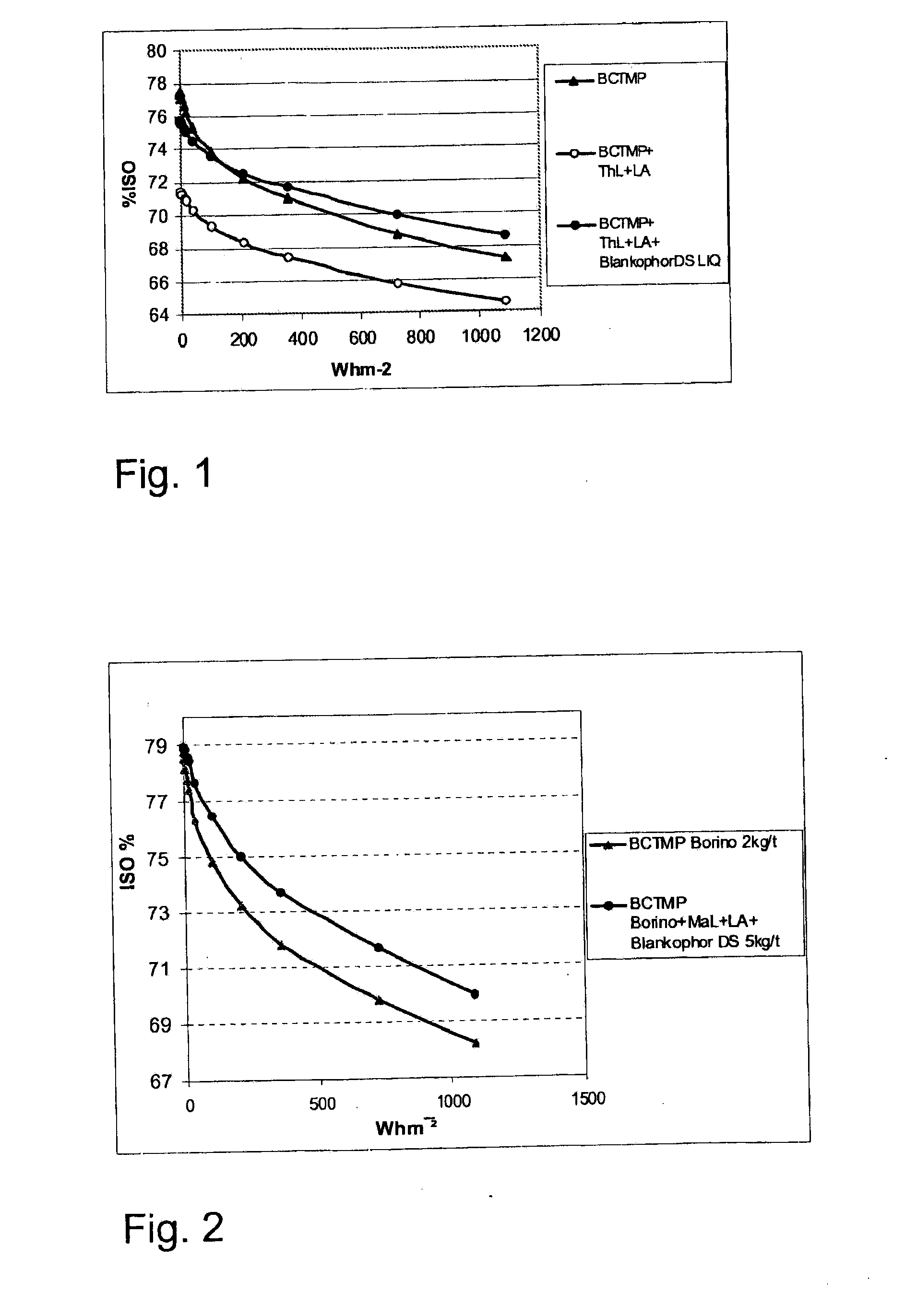Method for reduction of light-induced yellowing of lignin-containing material
a technology of fibrous materials and lignin, which is applied in the field of lignin-containing fibrous materials treatment methods, can solve the problems of reducing reflectivity, affecting the product's other properties, affecting the product's economic benefits, and many additives that have been found to prevent yellowing, etc., and achieves the effect of reducing or preventing yellowing and effectively reducing light-induced brightness reversion
- Summary
- Abstract
- Description
- Claims
- Application Information
AI Technical Summary
Benefits of technology
Problems solved by technology
Method used
Image
Examples
example 1
[0035]The treatments were started by cold disintegration of peroxide bleached aspen / spruce CTMP pulps. The pulps were additionally washed twice with water (80° C.) after the disintegration. The bonding was started by mixing 5 g of o.d. pulp with water, the pH of the pulp slurry was adjusted to pH 7. Thereafter, laccase (Trametes Hirsuta) was added (10 nkat / g). Laccase induced activation time was 1 min at 55° C. The linoleic acid (LA) was dissolved first in 1 ml of acetone and then added to the pulp slurry dropwise. Mixing time after addition of the LA was 39 min (55° C.). The dosage corresponded to 0.075 mmol linoleic acid / g pulp. The total treatment time was 40 min. After the treatment the pulp was filtrated twice and washed with water (with an amount equal to 20× dry weight).
[0036]After the enzymatic treatment the pulp was suspended into distilled water at a consistency of 0.625%. Fluorescent whitening agent (FWA) was diluted to a concentration of 0.5% and then added to pulp slurr...
example 2
[0040]The treatments were started by reductive treatment of the peroxide bleached aspen / spruce CTMP pulps. Pulps were diluted to the consistency of 10%, tempered to 60° C. prior to addition of Borino®. Charge of Borino was 0.1% and treatment time 3 minutes. During treatment pH was controlled to be >9. After treatment pulps were diluted with fresh water and washed twice with water.
[0041]The pulps were additionally washed twice with water (80° C.) after the disintegration. The bonding was started by mixing 5 g of o.d. pulp with water, and the pH of the pulp slurry was adjusted to pH 7. Thereafter laccase (MaL) was added (10 nkat / g). Laccase induced activation time was 1 min at 55° C. The linoleic acid (LA) was dissolved first in 1 ml of acetone and then added to the pulp slurry dropwise. Mixing time after addition of the LA was 39 min (55° C.). The dosage corresponded to 0.075 mmol linoleic acid / g pulp. The total treatment time was 40 min. After the treatment, the pulp was filtrated t...
PUM
| Property | Measurement | Unit |
|---|---|---|
| temperature | aaaaa | aaaaa |
| temperature | aaaaa | aaaaa |
| temperature | aaaaa | aaaaa |
Abstract
Description
Claims
Application Information
 Login to View More
Login to View More - R&D
- Intellectual Property
- Life Sciences
- Materials
- Tech Scout
- Unparalleled Data Quality
- Higher Quality Content
- 60% Fewer Hallucinations
Browse by: Latest US Patents, China's latest patents, Technical Efficacy Thesaurus, Application Domain, Technology Topic, Popular Technical Reports.
© 2025 PatSnap. All rights reserved.Legal|Privacy policy|Modern Slavery Act Transparency Statement|Sitemap|About US| Contact US: help@patsnap.com



